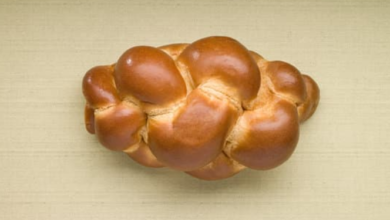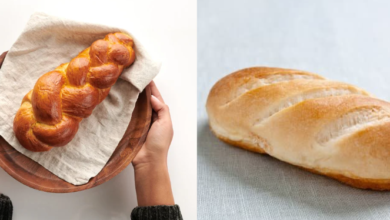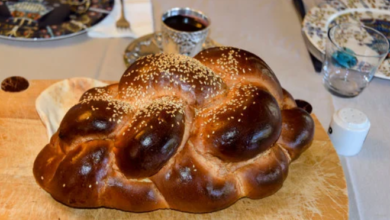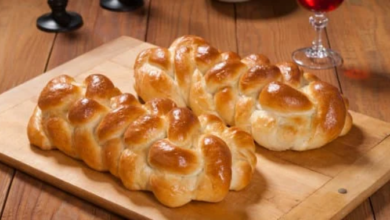Challah or Tsoureki: Which Braided Bread Will You Choose?
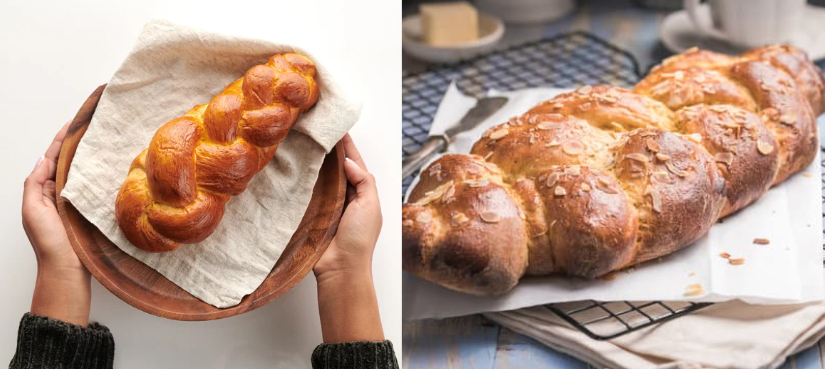
What To Know
- In this blog post, we embark on a culinary adventure to uncover the similarities and differences between challah and tsoureki, leaving you with a newfound appreciation for these delectable treats.
- The dough is kneaded until it becomes smooth and elastic, resulting in a soft and slightly sweet bread with a slightly golden crust.
- It is enjoyed as a breakfast bread, toasted with butter and jam, or used in sandwiches and French toast.
In the culinary realm, there exists a rivalry that has sparked debates and tantalized taste buds for centuries: the eternal battle between challah and tsoureki. These two braided bread masterpieces, each with a rich history and distinct flavor profile, have captivated bread lovers worldwide. In this blog post, we embark on a culinary adventure to uncover the similarities and differences between challah and tsoureki, leaving you with a newfound appreciation for these delectable treats.
History and Origins
Challah: A Jewish Heritage
Challah, a staple in Jewish cuisine, has been baked for thousands of years. Its origins can be traced back to the Bible, where it is mentioned as a sacred bread offering. Traditionally, challah is braided into intricate shapes, representing the 12 tribes of Israel.
Tsoureki: A Greek Delicacy
Tsoureki, on the other hand, is a beloved Greek bread with a history dating back to ancient times. It is often associated with Easter celebrations and is often decorated with red eggs, symbolizing new life and resurrection.
Ingredients and Flavors
Challah: Soft and Slightly Sweet
Challah is typically made with a combination of flour, water, yeast, sugar, eggs, and oil. The dough is kneaded until it becomes smooth and elastic, resulting in a soft and slightly sweet bread with a slightly golden crust.
Tsoureki: Rich and Aromatic
Tsoureki, in contrast, boasts a richer flavor profile. It is made with flour, water, yeast, sugar, eggs, butter, and a blend of spices that often includes cinnamon, nutmeg, and orange zest. The addition of butter and spices gives tsoureki a more aromatic and luxurious taste.
Texture and Appearance
Challah: Dense and Fluffy
Challah has a dense yet fluffy texture, with a slightly chewy interior and a thin, crispy crust. The braiding technique creates a beautiful and intricate appearance.
Tsoureki: Soft and Pillowy
Tsoureki is characterized by its soft and pillowy texture. It is lighter and more airy than challah, with a slightly flaky crust. The braiding is typically looser, resulting in a more open crumb structure.
Cultural Significance
Challah: A Symbol of Jewish Identity
Challah holds immense cultural significance in Jewish traditions. It is served at Sabbath meals, holidays, and special occasions, representing food, blessing, and community.
Tsoureki: A Symbol of Greek Heritage
Tsoureki is deeply rooted in Greek culture. It is a symbol of Easter, a time of renewal and celebration. The red egg decoration represents the blood of Christ and the promise of resurrection.
Culinary Uses
Challah: Versatile and Delicious
Challah’s versatility extends beyond religious ceremonies. It is enjoyed as a breakfast bread, toasted with butter and jam, or used in sandwiches and French toast.
Tsoureki: A Sweet Treat
Tsoureki is primarily consumed as a sweet treat. It is often served with coffee or tea, and it can also be filled with nuts, fruits, or chocolate.
Final Note: A Matter of Personal Preference
The debate between challah and tsoureki is ultimately a matter of personal preference. Both breads offer unique and delightful experiences, catering to different tastes and cultural traditions. Whether you prefer the soft and slightly sweet challah or the rich and aromatic tsoureki, one thing is for certain: these braided bread masterpieces will continue to grace tables and tantalize taste buds for generations to come.
Quick Answers to Your FAQs
Q: Which bread is sweeter, challah or tsoureki?
A: Tsoureki is generally sweeter than challah due to the addition of more sugar and spices.
Q: Which bread is more dense, challah or tsoureki?
A: Challah is denser than tsoureki, with a slightly chewy interior. Tsoureki is lighter and more airy.
Q: Which bread is more popular in the United States?
A: Challah is more popular in the United States, particularly among Jewish communities. Tsoureki is more commonly found in Greek communities and specialty bakeries.
Q: Can challah and tsoureki be made gluten-free?
A: Yes, both challah and tsoureki can be made gluten-free using alternative flours such as almond flour or coconut flour.
Q: Which bread is better for sandwiches?
A: Challah is a better choice for sandwiches due to its denser texture and ability to hold fillings well.
